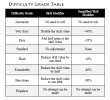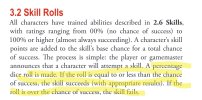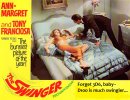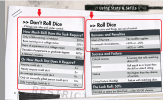Agemegos
Over-educated dilettante
- Joined
- May 15, 2021
- Messages
- 1,796
- Reaction score
- 5,875
Mythras (simple version) has bonus/penalty mods of +/-20%, +/- 40%. +/- 80%, and so forth.
The version I am thinking of modifies task difficulties by a proportion of the skill as follows:
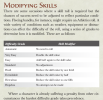
Now, the way it works in JB007, Classified, and ForeSight is that you generate and record not the character's percentage chance for a standard task, but the equivalent of one fifth of that value— the "Primary Chance". Then a standard task has an Ease Factor of 5; difficult tasks have lower integers, 0.5 or 0.25; easy tasks have higher Ease Factors up to 10. You multiply the Primary Chance by the modified Ease Factor to get the percentage chance of success. So there are twelve degrees of difficulty, each delivering a chance of success in proportion to that of a standard task. And with no arithmetic more taxing than a one-digit multiplication.
So there are 12 levels of difficulty that are susceptible to straightforward arithmetic with addition and subtraction of integer modifiers. And each of them works out to a proportion propability of the probability of success on a basic task. 5%, 10%, 20%, 40%, 60%, 80%, 100%, 120%, 140%, 160%, 180%, and 200% of basic chance, allowing finer modifications than Mythras and simpler arithmetic.
Then a roll less than or equal to one tenth of the chance of success is a Quality Rating 1, less that or equal to two-tenths is QR 2 if not better, less than or equal to half is QR 3 if not better, and a roll of chance-of-success or less is QR 4 (if not better) except if it's an 00. Rolls of 00 are automatic failures. Rolls over chance-for-success are failures¹ (JB007 and Classified provide only a table of the results and conceal the rule that generates it. ForeSight provides both.)
So there are five (in JB007 and Classified) or six¹ (in ForeSight) degrees of success or failure rather than the three provided by Mythras. With correspondingly more arithmetic (or table look-ups), but providing a lively interest in rolling as low as may be even when chance-of-success is well over 100%.
So long as the chance of success remains below 101 you can use a trick with the last digit: critical success or QR1 on a roll that ends in "0", QR2 on one that ends in "5", QR3 on one that ends in "3", "6", or "9", and QR4 otherwise. But, dealing often in chances that go well over 100%, I prefer to do the arithmetic.Critical Success is equal to 10% of Skill Value, so I just handwave it by making it the '10s' number (eg: 48% has a crit value of 4%, whereas 72% has a crit value of 7%). Seems easy enough in play.
¹ In ForeSight a roll greater than the success chance is QR 10 (a botch) if it ends in 0 and a QR 7 (ordinary failure) otherwise.
Last edited:



